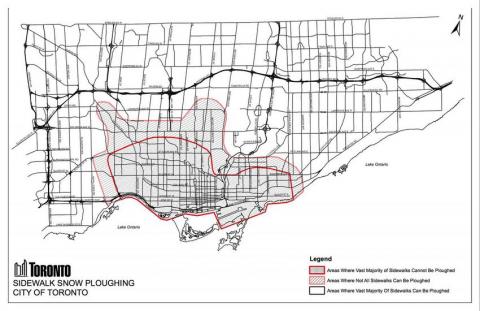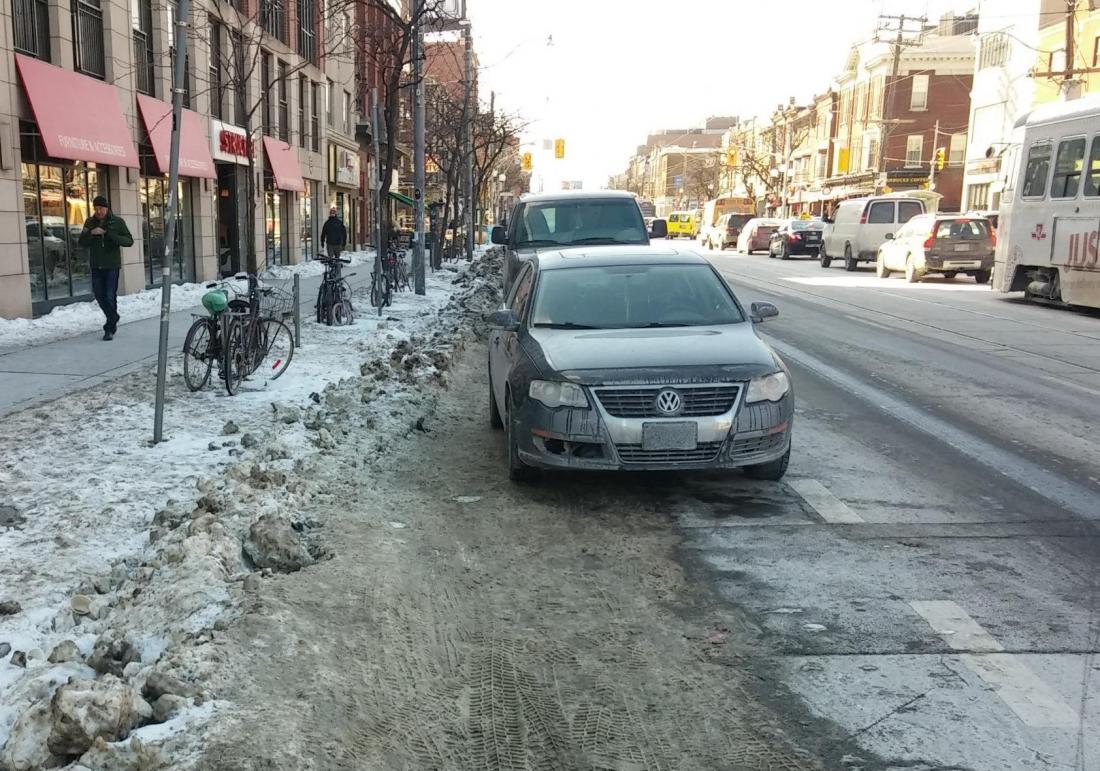
Snow Clearing: is Toronto Keeping Up?
by Ryan Shissler
I started bike commuting in February of 2010. At the time, I didn’t even think about how I was going to deal with snowy roads; I couldn’t afford to get to work any other way. Luckily, in 2010, Toronto had one of the lowest snowfall totals in recent history, and I made it to work safely every day.
That first year, I learned that riding a bike in the winter doesn’t have to be a challenge. Snow and ice-free roads can allow safe travel even in cold weather. Since that time, there has been a lot more snow, and the City of Toronto has started maintaining a network of cycling snow routes. It helps, but I know there is a lot of room for improvement.
Why does snow removal matter?
Imagine trying to get to a restaurant 3km away. In the summer, that’s a long walk or a short bike ride. In the winter, that can mean navigating sheets of ice and piles of snow. If the roads and sidewalks aren’t clear, it can be completely unsafe.
When heading out in the winter, you always have to consider whether the area will be cleared of snow. A lot of people will opt to stay at home if roads and sidewalks aren’t in good condition. People, businesses, and event organizers all miss out if it’s not safe to travel.
Having the same snow removal standards for bike routes and car routes isn’t acceptable; safe conditions for a 2-ton vehicle aren’t the same as those for a person on a bike. If we want people and businesses to thrive all year long, we can’t treat cycling routes the same as other areas. The number of times I’ve missed out because I know the bike lane will be buried in snow, days after the initial snowfall, is too many to count.
Current snow clearing
The City says it “meets or exceeds the winter maintenance levels of service for roadways, bike lanes and sidewalks as compared to other GTHA peer cities...” But Toronto isn’t like the other cities in the GTHA. We already have more people travelling by bike and foot, and the City has set a goal of having 75% of short trips being done by active transportation. Meeting this goal is impossible if it is unsafe in the winter.
The City clears a few, predominantly downtown, bike routes, and only suburban sidewalks. Neglecting to maintain routes for vulnerable road users takes away the choice to walk or bike. Toronto deserves to be treated like a major metropolitan city with accessibility for everyone. Continuing to do things the way they are isn’t good enough; as Toronto grows and changes, City services must reflect these changes.
Cycle Toronto has long advocated for increasing the number of routes that are cleared, and the number of times a bike lane is cleared. In order to make traveling in the city safe, this has to be done.
Currently, the City clears bike lanes based on the type of infrastructure under these guidelines:
| Road Category | When does the City start plowing? | How many hours after the snow stops falling will it take to clear? |
|---|---|---|
| Cycle Tracks | 5.0 cm | 6-8 hours |
| Arterial roads and streetcar routes | 5.0 cm | 6-8 hours |
| Collector roads, bus routes and local streets with hills | 5.0 cm – 8.0 cm | 8-10 hours |
Cycle tracks are treated the same as arterial roads, but if you’re not on a cycling snow route there isn’t even a provision to clear a bike lane.
Highlighted areas have limited or no sidewalk plowing provided by the City
How do we improve snow clearing in bike lanes?
- Remove snow more than once as it builds up, and follow up frequently
- Build protected bike lanes curbside, so that cars don't drag snow through the bike lane as they park
- Ban overnight parking as needed to clear roads that don’t have protected bike lanes, like College St, so they can be cleared curb-to-curb overnight
- Don’t shovel snow into bike lanes from sidewalks and driveways, and enforce bylaws that prohibit clearing snow from private property onto roadways.
If bike lanes are cleared quickly after a snowfall, they can remain clear for many days with proper maintenance. Riding can be a breeze soon after snow first hits the ground. However, if bike lanes aren't cleared in time, the freeze-thaw cycle can mean that snow compacts into thick sheets of ice, and can't be easily removed.
Where cars cross over bike lanes to access driveways, parking, and intersections they drag snow into the bike lanes. It can feel like you’re competing in a cyclocross event just trying to use a bike lane. Even after the initial snowfall and plowing, bike lanes need to be maintained.
If you’ve ever ridden on a street with parking on the outside of bike lanes, you know that snow accumulates in parking spots.It prevents proper parking, causing snow and cars to spill out into the bike lanes until the spring thaw comes. Designated, overnight, snow clearing times are needed. When parking is allowed 24 hours a day, it is impossible to clear the entire road.
Cars and snow in bike lane on College. Photo courtesy of Johnathan Studiman
What's next?
In early October, Councillor Mike Layton proposed that the City review its winter maintenance program. Two-thirds support was required and the motion failed. Councillor Layton will bring his proposal to the Budget Committee, and Cycle Toronto will present its requests to improve winter cycling conditions in the City, outlined above.
What can you do?
When you see a bike lane that hasn't been cleared or needs to be re-cleared, call or email 311. You can tweet @311Toronto, and tag us as well @CycleToronto. Your voices make ours stronger. #FrostBikeTO
Read more
Want to support winter cycling in Toronto?
Consider becoming a member for as little as $5 per month. You’ll be helping support our strong voice in City Hall, and you’ll get of load a benefits as well.

